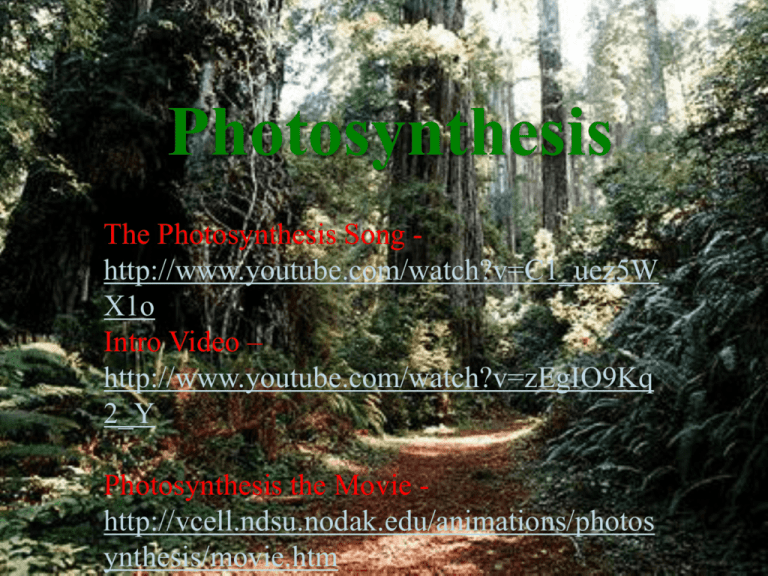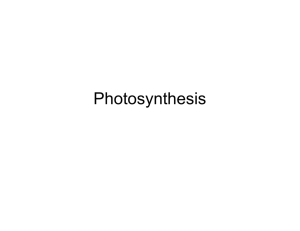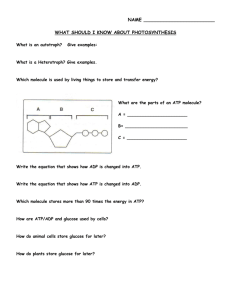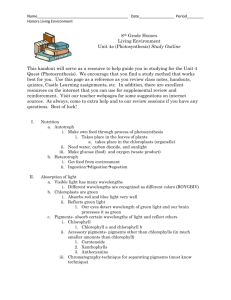
Photosynthesis
The Photosynthesis Song http://www.youtube.com/watch?v=C1_uez5W
X1o
Intro Video –
http://www.youtube.com/watch?v=zEgIO9Kq
2_Y
Photosynthesis
Photosynthesis the Movie http://vcell.ndsu.nodak.edu/animations/photos
ynthesis/movie.htm
Objectives
1. Summarize how energy is captured from sunlight
during the light dependent reactions of
photosynthesis.
2. Analyze the function of electron transport chains
during the light dependent reactions of
photosynthesis.
3. Relate the Calvin cycle to carbon dioxide
fixation in photosynthesis.
4. Identify three environmental factors that affect
the rate of photosynthesis.
Using the
Energy in
Sunlight
Plants, algae, and some
bacteria capture 1% of the
sunlight that reaches earth and
convert it to chemical energy
through the process of
photosynthesis.
History of the Discovery of
Photosynthesis
The following people all contributed to the discovery
of photosynthesis.
Van Helmont (1600’s)
Priestley (1700’s)
Ingenhousz (1779)
Mayer (1845)
Ruben and Kamen (1941)
Melvin Calvin (1948)
Rudolph Marcus (1992)
Jan van Helmont
He wondered where the mass of a
tree came from- perhaps the soil?
To find out, he did an experiment
where he weighed a seedling and a
pot of soil. After 5 years, he
reweighed them both.
The soil was the same mass but the
tree had gained mass. Where did it
come from?
He concluded it came from the water!
Joseph Priestley (1700’s)
He put a jar over a candle and found?
The candle went out!
But when he placed a living plant
under the jar with the candle, it stayed
lit longer. Why???
The plant produced….OXYGEN!
Jan Ingenhousz
He did the same experiment as
Priestley, but in the dark and in the
light.
It only worked in the light, proving
that plants need light to make
oxygen!
Photosynthesis is…
The process where plants, algae and some
bacteria convert light energy into chemical
energy (glucose), using water and carbon
dioxide and releasing oxygen gas as a
byproduct.
A. Introduction
1. Location: chloroplasts (in plants and algae) or
folds in cell membrane (in photosynthetic
prokaryotes, cyanobacteria)
Stages of Photosynthesis
Stage 1 Light-dependent reaction
Chlorophyll pigments capture light energy
Stage 2 Light-dependent reaction
Thylakoid
membranes
Light energy converted to chemical energy.
Production of ATP and NADPH
Stage 3 Light-independent reaction
Reduction of CO2 to glucose:
using ATP + NADPH + H+ to synthesize
organic compounds (glucose) from CO2
(carbon fixation); process called Calvin cycle;
© Teachable and Louise Edgeworth. Some rights reserved. http://teachable.net/res.asp?r=6615
Stroma
3. Overall process:
6CO2 + 12H2O + light
chlorophyll
C6H12O6 + 6O2 + 6 H2O
the carbon + oxygen from CO2 and the H from H2O
produce the glucose
the oxygen from H2O is released as oxygen gas
LIGHT AND PIGMENTS
Light has different
wavelengths.
You can only see visible
light.
Visible spectrum
Sunlight contains a
mixture of all the
wavelengths (colors)
of visible light.
When sunlight passes
through a prism, the
prism separates the
light into different
colors.
4. Light energy:
light energy travels in wave packets called photons
visible light has a wavelength of 380 nm (violet)
to 750 nm (red) (ROYGBIV)
short wavelengths [violet] is high energy
long wavelengths [red] is low energy
Pigments
Pigments are light-absorbing
molecules which absorb only
certain wavelengths and reflect all
of the others.
Chlorophyll is
the pigment in
plants that
makes them
appear green.
GREEN is
reflected, while
all other colors
are absorbed.
chlorophyll a (primary light absorbing pigment in all
photosynthetic organisms) and chlorophyll b absorb
photons of blue-violet λ and red-orange λ
green λ are reflected (that is why leaves appear green)
and green is transmitted so leaves look green
from underneath
Chlorophyll • Absorbs mostly blue and red light and
reflects green and yellow light.
• Thus, the plant looks green.
Carotenoids Pigments in plants that absorb blue and
green light and reflect yellow and orange.
Autumn Colors
In the fall, as it gets colder, chlorophyll gets broken down
because photosynthesis cannot occur in the winter. Why?
• Water freezes!
• And if water freezes, it cannot do its part in photosynthesis.
Inside a Chloroplast
CHLOROPLAST STRUCTURE
Thylakoids
Are disk shaped structures
containing clusters of pigments
embedded in their membranes.
This is where the LightDependent Reactions occur.
Great Animation of
Photosynthesis!
http://dendro.cnre.vt.edu/forestbiology/pho
tosynthesis.swf
Overview of The Light-Dependent
Reactions
Where do they
occur?
What are they?
The Thylakoid
Membranes where
there is chlorophyll!
The light-dependent
reactions use water,
produce oxygen gas
and convert ADP and
NADP+ into the
energy carriers ATP
and NADPH.
Light-dependent reaction
Chlorophyll
molecules are
arranged on the
thylakoid membranes
in groups called
PHOTOSYSTEMS.
There are two types
of photosystems PSI
and PSII.
© Teachable and Louise Edgeworth. Some rights reserved. http://teachable.net/res.asp?r=6615
Thylakoid membranes
Electron carrier
molecules and
ATP synthase are
also located on
the thylakoid
membranes.
© Teachable and Louise Edgeworth. Some rights reserved. http://teachable.net/res.asp?r=6615
Overview of The LightDependent Reactions
What part of the
photosynthesis
equation is
involved?
Water (H2O) is broken
apart for its electrons.
Oxygen gas (O2) is
given off as a waste
product.
Glucose
The energy captured in the light-dependent
reaction is used for:
1. Direct synthesis of ATP – a process called
photophosphorylation.
2. Splitting water into H+ ions and OH- ions – a
process called photolysis.
© Teachable and Louise Edgeworth. Some rights reserved. http://teachable.net/res.asp?r=6615
STEPS OF THE LIGHT
DEPENDENT REACTIONS
B. Light Reactions
1. Photoexcitation
e- are normally stable in their ‘ground state’, the
lowest possible energy level
when a photon strikes a chlorophyll molecule, the ehave energy added to them and are in a state of
‘excitation’
an excited e- has more energy than one in a ground
state, but it will return to the ground state in 1
billionth of a second
if left alone, the e- returns to the ground state and
releases energy (heat + light)
instead of the e- from chlorophyll releasing heat +
light, they are captured by a primary e- acceptor
(chlorophyll is oxidized, e- acceptor is reduced)
2. Photosystems
photosystems = a group of pigments that work
together to capture light
the antenna complex consists of several hundred
pigment molecules that capture light of different
wavelengths and pass energy to the reaction center
the reaction center is a chlorophyll a pigment that
takes all the energy and uses it to excite an
electron
the excited e- is transferred to an e- acceptor
(chlorophyll is oxidized, primary e- acceptor is
reduced)
3. Sources of electrons:
a) bacteria:
photosystem I contains chlorophyll P700 (max.
absorption at 700 nm λ)
the photosystem I does not have enough energy to break
water, however it does have enough energy to
break H2S
but H2S is rare; only found in sulphur springs
6CO2 + 12H2S + light energy
C6H12O6 + 6H2O + 12S
Sulphur springs
b) algae and plants
photosystem II contains chlorophyll P680
(max. absorption at 680 nm λ)
photosystem II does have enough energy to
break water
electrons are then passed to photosystem I
6CO2 + 12H2O + light energy
C6H12O6 + 6H2O+ 6O2
c) photosystem I and II are used to produce
ATP + NADPH + H+
4. Photolysis (the breaking of water by sunlight)
the Z protein (in the thylakoid space) uses energy
from light to split H2O
2 e- are given to photosystem II
2 H+ are released in the thylakoid space and create
an electrochemical gradient
O2 leaves the chloroplast as waste
5. Electron Transport System
a series of proteins that move electrons and protons to
produce high energy compounds
PROTEINS
Z –protein
1. photosystem II 3. cytochrome b6-f
5. photosystem I
2. PQ plastoquinone 4. PC plastocyanin 6. ferredoxin
7. NADP reductase
8. ATP synthase
2H+
stroma
P680
P700
2H+
ADP +Pi
NADP+
ATP
NADPH + H+
6
1
3
7
2
5
2e-
H20
2e-
z
½ O2 +
8
4
2H+
2H+
2H+
5. Electron Transport System
a) occurs in the thylakoid membrane
b) photon strikes photosystem II and excites 2e- of
chlorophyll P680, 2e- passed to electron acceptor
called plastoquinone (PQ)
c) 2e- from Z protein replace the missing 2e- from
chlorophyll P680
d) PQ takes 2e- from photosystem II and moves with
them to b6-f complex
e) b6-f complex takes 2e- and passes them onto
plastocyanin which allows 2H+ to pass from the
stroma into the thylakoid space;
f) this creates an electrochemical gradient
g) Pc takes 2e- and moves with them to photosystem I
(these replace 2e- lost when photosystem I was
struck by a photon)
h) photosystem I transfers 2e- to ferredoxin (Fd)
(an e- acceptor)
i) Fd transfers 2e- to NADP reductase
j) NADP reductase passes on the 2 e- to NADP+
k) (NADP+ + 2H+ + 2e- NADPH + H+)
6. Types of Electron Transport Systems
a) non-cyclic phosphorylation
normal process as described in notes
involves both P700 and P680 and transfers e- from
H2O to NADP+ to produce
1 NADPH + H+ and 2 ATP needed to make glucose
H2O + photons + 2ADP + 2Pi + NADP+
½O2 + 2ATP + NADPH + H+
but demand for ATP and NADPH + H+
is not always in a 2:1 ratio
b) cyclic phosphorylation
happens in all plants when extra ATP is needed
the process produces only ATP and not NADPH + H+
one of the proteins [Fd] in the thylakoid membrane
shifts in order for the cycle to flow
Cyclic phosphorylation
2H+
stroma
P700
2H+
ADP +Pi
ATP
6
6
2e-
1
3
7
2
8
5
z
4
2H+
2H+
PROTEINS
Z –protein
1. photosystem II 3. cytochrome b6-f
5. photosystem I
2. PQ plastoquinone 4. PC plastocyanin 6. ferredoxin
7. NADP reductase
8. ATP synthase
photosystem I (P700) is involved,
but not photosystem II (P680)
electrons from P700 are excited but eventually
return to P700 (H2O & NADP+ are not involved)
P700 Fd b6-f complex protein C P700
b6-f complex pumps H+ ions across the thylakoid
membrane, creating an electrochemical gradient
which is used to make ATP
Summary of Light dependent reaction
1. Pigments in the thylakoids of chloroplasts
absorb light energy.
2. Electrons in the pigments are excited by light
and move through electron transport chains in
thylakoid membranes.
3. These electrons are replaced by electrons from
water molecules, which are split by an enzyme.
4. Oxygen atoms from water molecules combine to
form oxygen gas.
5. Hydrogen ions accumulate inside thylakoids,
setting up a concentration gradient that provides
the energy to make ATP.
Light Dependent Reactions
Review of Light Dependent Reactions!
Pigment molecules absorb energy at which
stage of photosynthesis?
The beginning of the Light-Dependent Reactions!
At which stage of photosynthesis is light energy
stored as ATP and NADPH?
The end of the Light-Dependent Reactions!
At which stage of photosynthesis are excited
electrons passed along an electron transport chain?
Light-Dependent
Reactions!
Where do the light-dependent reactions occur?
The thylakoid
membranes!
What goes into the light-dependent reactions?
Light excites the electrons of chlorophyll.
Water is split to replace lost e-’s in chlorophyll.
ADP gets a phosphate group to become ATP.
NADP+ gets hydrogen ions to become NADPH.
What is produced in the light-dependent reactions?
ATP and NADPH go into the Calvin Cycle.
Oxygen gas is released into the atmosphere.
Light Reactions Animation
http://www.johnkyrk.com/photosynthesis.html
light reaction animation on moodle
1. Photosynthesis Animation by John L. Giannini
2. http://www.learnerstv.com/animation/animation.ph
p?ani=179&cat=Biology photosynthesis tutorial








